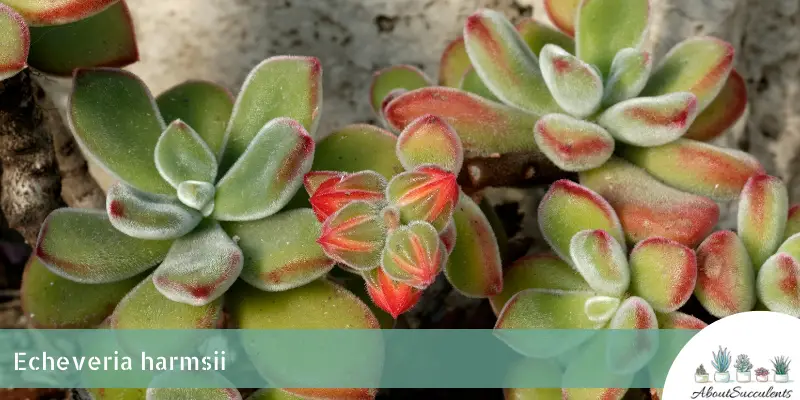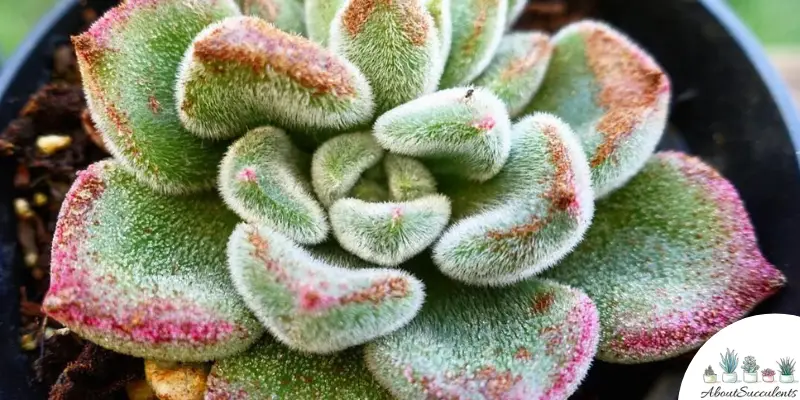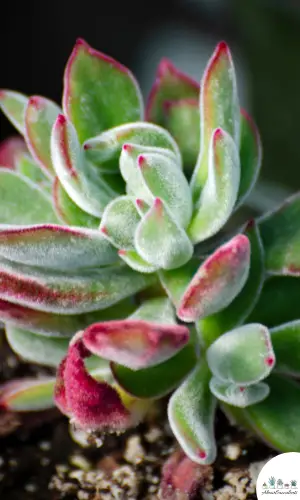
Echeveria Harmsii, also known as Plush Plant or Red Echeveria is a charming evergreen succulent shrub that’s popular with hobbyists because of its adorable appearance.
The Plush Plant grows beautiful rosettes of fleshy, lance-shaped, green leaves with red edges. It can reach up to 30cm (12”) in height and width when it matures. The plush leaves covered in silver velvet grow up to 3cm (1.2”) long.
In spring, it blooms red-orange, bell-shaped flowers with yellow tips. The flowers grow up to 3cm (1.2”) long and are attached to slender stalks that grow up to 10cm (4”)in length.
Red Echeveria is a native of Mexico. It belongs to the Echeveria genus from the Crassulaceae family.
General Information:
Also known as: Plush Plant, Red Echeveria
Plant Family: Crassulaceae
Origin: Mexico
Height: 30cm (12”)
Exposure: Full sun
Water Needs: Drought-resistant, “soak and dry” watering method
Soil Mix: Well-draining soil mixed with ingredients as bark, perlite, gravel, and sand to improve drainage.
Soil pH: 5.6 to 6.0
How to Grow and Care for Echeveria Harmsii

Echeveria Harmsii is easy to grow and care for. It is a perfect addition to rock gardens or dish containers. This small succulent plant is popular among collectors because of its adorable flowers.
Plush Plant is not cold-hardy but it can tolerate cold temperatures as low as +1.7°C (35°F). This type of succulent loves warm climates and grows best in temperatures of 10°C – 21°C (50°F – 70°F). Echeveria Harmsii can thrive indoors and outdoors.
Sunlight
Echeveria Harmsii loves basking in the sun. Plant them in an area of your garden where it can get at least 6 hours of full to partial sunlight daily.
Intense direct midday sunlight will scorch the leaves. Lack of light will result in etiolation, where the leaves stretch out toward the light source. The plant will wither and weaker as the leaves turn pale.
Indoors, place your Plus Plant pot in a spot that gets a lot of light for 6 hours. During winter, place it on a southern-facing window.
Watering

Plush Plant prefers the “soak and dry” method of watering. They do not like to be overly soaked nor be overly dry.
Water the soil all the way through to ensure that the soil columns get soaked. Allow it to dry completely before watering again.
Before you water, test the soil moisture with a stick. Insert the stick into the soil and if it comes out dry, it’s time to water the soil. When watering, give the soil a good soak.
Pot and Soil
Use a ceramic or terracotta pot with good drainage to grow your Echeveria Harmsii. Succulents grow best in breathable pots with drainage holes in the bottom. Make sure the drainage hole has a mesh net to keep the soil from falling out.
If you buy Plush Plants from a nursery, they might be potted in a glass or plastic container. When you get home, transfer your plant to a ceramic or terracotta pot right away.
Echeveria Harmsii grows best in well-draining soil with little moisture-retention quality. The best soil mix is made up of little clay or peat moss combined with a lot of gritty materials such as bark, perlite, gravel, and sand.
Echeverias can grow healthy without fertilizer but adding extra nutrients might help. You can use a slow-release fertilizer such as a low nitrogen mix or a cactus fertilizer at the onset of spring.
How to Propagate Echeveria Harmsii
If you want more Echeverias in your home, you can propagate them in three ways: Offsets, Leaf cuttings, or Germinating Seeds.
Offsets Method
Step 1: Look at the base of the Plush Plant and check the rosettes or plantlets.
Step 2: Use a clean, sharp knife or pruning shears to cut off the offsets from the stem. If the plantlets are not securely attached to the stem, gently pull them from the parent plant.
Step 3: Place the offsets in a warm spot for 2 to 3 days to let it callus and allow the roots to dry out.
Step 4: Plant the rosettes with roots in a pot filled with well-draining succulent soil mixed with gritty materials. If you have offsets without roots, just place them right side up on top of your Echeveria potting mix.
Step 5: Wet the soil and place the pot where it can get plenty of indirect sunlight. Use the “soak and dry” watering method over the next four weeks.
Leaf Cuttings Method
Step 1: Select healthy lower leaves without scars or other signs of damage.
Step 2: Gently grasp each leaf and move it sideways until it snaps offs. Discard leaves that are torn or incomplete.
Step 3: Set up your leaves in a warm area exposed to indirect sunlight. Leave them for 2-3 days to allow the wounds to callus.
Step 4: Place your callused Echeveria Harmsii leaves on top of a well-draining soil mixed with gritty materials.
Step 5: Place the pot in a location where it gets plenty of indirect sunlight. Lightly mist the leaves and soil over the following weeks. When the roots appear, cover them with a thin layer of soil and continue misting.
Germinating Seeds
Step 1: Mix one part of Echeveria Harmsii seeds with two parts of fine sand.
Step 2: Prepare a growing tray with well-draining soil mixed with gritty materials. Wet the soil mix thoroughly. Spread the seeds on top of the soil.
Step 3: Place the tray in an area where it can get plenty of indirect sunlight. Mist the seeds and soil every day. If you live in a location with a dry climate, cover the tray with plastic wrap.
Step 4: Remove the plastic cover when seedlings appear and use the “soak and dry” watering method.
Frequently Asked Questions
Is Echeveria Harmsii Toxic to Cats and Dogs?
Echeveria Harmsii is not listed as toxic to animals on the website of the American Society for Prevention of Cruelty to Animals (ASPCA).
Why are my Plush Plants Dying?
If your Echeverias are showing signs of weakness, the reasons could be overwatering and pest infestation. The succulent plant will die unless it is attended to right away.
Overwatering
The schedule of watering Echeveria Harmsii is crucial to their survival. Watering before the soil gets dry will cause the roots to rot and cause fungal growth.
The good news is that you can still save your overwatered Plush Plant. Remove the damaged parts with a sanitized and sharpened knife or pruning shears.
Gently pull out Echeveria Harmsii from wherever it is planted and dust off excess soil from its roots. Remove the damaged roots and let the plant completely try for 3-7 days in an area exposed to partial sunlight.
Replant in well-draining soil mixed with gritty materials.
Pest Infestation
Echeverias are susceptible to mealybugs infestation. You can remove mealybugs by spraying the leaves with 70% isopropyl alcohol. Repeat weekly until you do not see any more nasty bugs on your Plush Plants.
You can also use neem oil. Mix diluted neem oil with water and a few drops of soap. Spray it all over your succulent plant.
After spraying your Plush Plant with alcohol or neem oil, do not expose it to direct sunlight to prevent sunburn.
Does Echeveria Harmsii Produce Flowers?
Yes, Echeveria Harmsii blooms bright red-orange flowers in the springtime.
Last Updated on June 9, 2022 by Sofia Lara